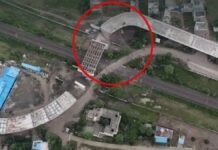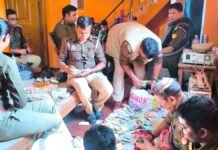
Key Points
- Woman alleges husband and in-laws forced 3-hour daily workouts to look like actress Nora Fatehi; denial of food on refusal.
- Dowry harassment alleged despite family spending ₹76 lakh on wedding; husband reportedly called her “fat and ugly.”
- Complaint includes claims of assault, forced abortion pressure, and exposure to “objectionable” online videos.
- Husband identified as government-school physical education teacher; police confirm FIR and probe initiated.
- Case registered at women’s police station; investigation underway under relevant sections for cruelty, dowry, assault, and coercion.
Ghaziabad: A woman in Ghaziabad has filed a police complaint accusing her husband and in-laws of extreme coercion and cruelty, alleging she was forced to undertake rigorous gym sessions for hours daily to emulate Bollywood actor-dancer Nora Fatehi’s physique. According to the complaint, refusal to comply allegedly resulted in her being deprived of food and subjected to humiliation and assault.
Key Allegations In The FIR
- Fitness coercion and starvation: The husband and in-laws allegedly demanded a strict 3-hour daily exercise regimen; on refusal, the woman claims she was denied meals.
- Body-shaming and abuse: The husband, reportedly a physical education teacher at a government school, allegedly called her “fat and ugly,” while continually pressuring her to look like Nora Fatehi.
- Dowry harassment: Despite her family spending over ₹76 lakh on the wedding six months ago, she alleges persistent demands and harassment for additional dowry.
- Assault and forced-abortion pressure: The complaint states the in-laws pressured her to terminate a pregnancy and that the husband assaulted her on multiple occasions.
- “Objectionable” content: The woman has also alleged that her husband frequently watched explicit content online, adding to her distress.
Police Response
Assistant Police Commissioner (ACP) Saloni Agarwal confirmed that the complaint has been lodged at the women’s police station, and an FIR has been registered. Investigators have begun recording statements, collecting medical evidence where applicable, and verifying claims regarding dowry, bodily harm, and coercion. Appropriate sections under IPC and Dowry Prohibition laws are expected to be invoked following preliminary inquiry.
Legal Context
- Dowry-related cruelty: Allegations may fall under IPC Section 498A (cruelty by husband or relatives), with additional sections for assault and criminal intimidation as substantiated.
- Forced abortion pressure: Depending on the facts, relevant provisions under the IPC and the Medical Termination of Pregnancy (MTP) Act may be examined.
- Coercion and starvation: These allegations can attract charges related to hurt, wrongful confinement/coercion, and mental/physical cruelty.
What Happens Next
- Evidence collection: Police will seek medical examination reports (if assault is alleged), device/phone records, and witness statements.
- Statements and verification: The husband and in-laws will be called for questioning; any CCTV or gym records, if relevant, may be checked.
- Protective measures: Police can consider immediate protection under the Protection of Women from Domestic Violence Act, including residence orders and restraining directions, if sought by the complainant.
Safety And Support For Survivors
- Helplines: Women’s helpline 181; Police emergency 112.
- Legal aid: District Legal Services Authority (DLSA) can arrange free legal counsel and support services.
- Protection orders: Under the Domestic Violence Act, survivors can seek protection, residence, maintenance, and counseling support through fast-track mechanisms.
Public Interest Note
Body-shaming, coercive control, and starvation as a form of punishment are forms of domestic abuse and can have severe physical and psychological consequences. Law enforcement encourages prompt reporting, medical documentation of injuries, and preservation of digital/communication evidence.





















































